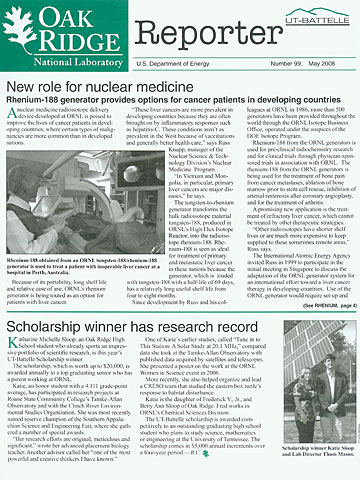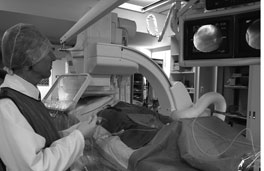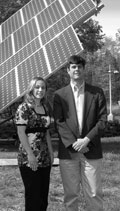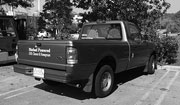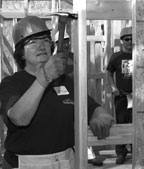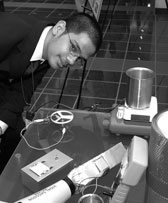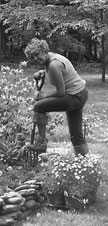 |
Number 99, May 2008 |
 New role for nuclear medicine
New role for nuclear medicine
Rhenium-188 generator provides options for cancer patients in developing countries
|
|
Rhenium-188 obtained from an ORNL tungsten-188/rhenium-188 generator is used to treat a patient with inoperable liver cancer at a hospital in Perth, Australia. |
A nuclear medicine radioisotope delivery
device developed at ORNL is poised to improve the lives of cancer patients in developing countries, where certain types of malignancies are more common than in developed nations.
Because of its portability, long shelf life and relative ease of use, ORNL’s rhenium generator is being touted as an option for patients with liver cancer.
“These liver cancers are more prevalent in developing countries because they are often brought on by inflammatory responses such as hepatitis-C. These conditions aren’t as prevalent in the West because of vaccinations and generally better health care,” says Russ Knapp, manager of the Nuclear Science & Technology Division’s Nuclear Medicine Program.
“In Vietnam and Mongolia, in particular, primary liver cancers are major diseases,” he says.
The tungsten-to-rhenium generator transforms the bulk radioisotope material tungsten-188, produced in ORNL’s High Flux Isotope Reactor, into the radioisotope rhenium-188. Rhenium-188 is seen as ideal for treatment of primary and metastatic liver cancer in these nations because the generator, which is loaded with tungsten-188 with a half-life of 69 days, has a relatively long useful shelf life from four to eight months.
Since development by Russ and his colleagues at ORNL in 1986, more than 500 generators have been provided throughout the world through the ORNL Isotope Business Office, operated under the auspices of the DOE Isotope Program.
Rhenium-188 from the ORNL generators is used for pre-clinical radiochemistry research and for clinical trials through physician-sponsored trials in association with ORNL. The rhenium-188 from the ORNL generators is being used for the treatment of bone pain from cancer metastases, ablation of bone marrow prior to stem cell rescue, inhibition of arterial restenosis after coronary angioplasty, and for the treatment of arthritis.
A promising new application is the treatment of refractory liver cancer, which cannot be treated by other therapeutic strategies.
“Other radioisotopes have shorter shelf lives or are much more expensive to keep supplied to these sometimes remote areas,” Russ says.
The International Atomic Energy Agency invited Russ in 1999 to participate in the initial meeting in Singapore to discuss the adaptation of the ORNL generator system for an international effort toward a liver cancer therapy in developing countries. Use of the ORNL generator would require set-up and use in the radiopharmacies, effective concentration of the rhenium-188 and attachment to the appropriate carrier radiopharmaceutical, which could be selectively delivered to the individual tumors.
“The IAEA identified hospitals in 13 countries who expressed interest in participating. We agreed to provide protocols on how to use the system and provided guidance on use of the generator and rhenium-188 concentration methods.We then worked with colleagues in the Nuclear Medicine Department at the Seoul National University Hospital in Korea for development of the HDD carrier molecule to which the concentrated rhenium-188 would be attached,” Russ says.
Subsequent meetings determined which patients would qualify, based on the nature of their tumors and their patient history. Then the appropriate clinical protocols were developed.
|
Russ Knapp |
The tungsten-rhenium generator, one of ORNL’s most successful nuclear medicine inventions, is a fairly simple device. The generator comes with a supply of tungsten-188, which is bound to an aluminum oxide material in the generator. The rhenium-188, a decay product with a half-life of around 17 hours, does not bind to the aluminum oxide. When a solution is passed through the generator, the rhenium-188 simply washes off.
The rhenium-188 is then chemically bound to the fat soluble HDD agent, which is then mixed with Lipiodol, which is essentially a fatty acid widely used in radiology as a contrast agent for the visualization of soft tissue. The rhenium-188-HDD is selectively delivered to the tumors by use of a catheter navigated through a blood vessel to the tumors.
“Most organs receive their blood supply through arteries. The liver, however, is different; it obtains its blood from the portal veins. The blood supply to these liver tumors, on the other hand, is from the hepatic arteries, which provide good access by way of a catheter threaded through the femoral artery,” Russ says.
The High Flux Isotope Reactor, with its high neutron thermal flux, is the only reactor in the West capable of irradiating the tungsten-188 targets.
|
Nuclear medicine was practically invented at ORNL. ORNL’s Graphite Reactor produced the first shipments of radioisotopes for medical uses.
|
The interventional radiologist feeds the catheter through the femoral artery and then uses a contrast agent to locate the tumor vasculature. Once the catheter is positioned for selective delivery to the tumor, the Re-188-HDD radiopharmaceutical is then delivered from a syringe, with specific localization and uptake into the tumor cells.
This selective localization of the radioactive agent within the tumor cells then provides the very high-energy-emitting radiation specifically to the tumor cells with minimal radiation exposure of the normal liver tissue.
For the patient, the Rhenium-188-HDD treatment is mainly palliative; that is, it relieves pain by shrinking the tumor. These cases are usually inoperable and terminal, although the treatment eventually could prove to be therapeutic. The treatment has undergone 60 clinical trials.
The intravenous treatment is particularly preferable to the use of external conventional radiation treatments in many of these cases, because selective delivery of the radioactive rhenium-188-HDD source minimizes potential damage to surrounding tissue, Russ says. Such damage can be minimized or avoided by selective tumor delivery of the radioactive HDD agent.
Russ was also invited to participate in an international symposium in Ulaanbaatar, Mongolia, in 2007, where the results of these studies were highlighted. A recent issue of the Seminars in Nuclear Medicine (March 2008) has highlighted use of the ORNL generator, development of the HDD and a discussion of the joint clinical data.
Nuclear medicine and the use of radioisotopes for diagnosis and treatment strategies was practically invented at ORNL, in conjunction with Oak Ridge Associated Universities. ORNL’s Graphite Reactor produced the first shipments of radioisotopes for medical uses in 1946.
Although the routine production and processing of most medical radioisotopes is now primarily conducted in the private sector, the national laboratories still fulfill an important role in providing those radioisotopes that must be specifically produced at the DOE facilities.
As a result of this handoff to industry, where in the 1950s and 1960s ORNL made more than 1,500 radioisotope shipments per month, in 2007 there were 200 shipments for the entire year of medical and industrial radioisotopes that are uniquely produced in the HFIR and from other sources at ORNL.
“Production of tungsten-188 for our generator is a key example, since very high thermal neutron flux is required to irradiate the targets, and the HFIR is the only reactor in the West with this capability,” Russ says.
Over the last two years Russ and his colleagues have been developing a current Good Manufacturing Practice quality program, through which the generators will be provided to manufacturers for preparation of the various rhenium-188-labeled agents for therapeutic use.
As medical technologies progress, nuclear medicine often takes a back seat to other treatments when they become available. The Rhenium-188-HDD radiopharmaceutial treatments, however, are expected to be extremely promising in the developing nations where state-of-the-art medicine isn’t available. And the rhenium-188 generator can be shipped virtually anywhere in the world.
“This is a perfect example of effective translational research—from bench to bedside—and illustrates the continuing important role played by the HFIR and radioisotope technology development at ORNL,” Russ says.—B.C. ![]()
 Scholarship winner has research record
Scholarship winner has research record
|
|
Scholarship winner Katie Sloop and Lab Director Thom Mason. |
Katharine Michelle Sloop, an Oak Ridge High School student who already sports an impressive portfolio of scientific research, is this year’s UT-Battelle Scholarship winner.
The scholarship, which is worth up to $20,000, is awarded annually to a top graduating senior who has a parent working at ORNL.
Katie, an honor student with a 4.111 grade-point average, has participated in research projects at Roane State Community College’s Tamke-Allan Observatory and with the Clinch River Environmental Studies Organization. She was most recently named reserve champion of the Southern Appalachian Science and Engineering Fair, where she gathered a number of special awards.
“Her research efforts are original, meticulous and significant,” wrote her advanced placement biology teacher. Another advisor called her “one of the most powerful and creative thinkers I have known.”
One of Katie’s earlier studies, called “Tune in to This Station: A Solar Study at 20.1 MHz,” compared data she took at the Tamke-Allan Observatory with published data acquired by satellites and telescopes. She presented a poster on the work at the ORNL Women in Science event in 2006.
More recently, she also helped organize and lead a CRESO team that studied the eastern box turtle’s response to habitat disturbance.
Katie is the daughter of Frederick V., Jr., and Betty Ann Sloop of Oak Ridge. Fred works in ORNL’s Chemical Sciences Division.
The UT-Battelle scholarship is awarded competitively to an outstanding graduating high school student who plans to study science, mathematics or engineering at the University of Tennessee. The scholarship comes in $5,000 annual increments over a four-year period.—B.C. ![]()
 Green initiative draws award from White House
Green initiative draws award from White House
|
|
The familiar E85 trucks played a role in the Lab’s receiving a White House Closing the Circle Award. |
ORNL’s Green Transportation Initiative
has received a White House Closing the Circle Award, recognizing outstanding federal environmental Stewardship practices.
The Office of the Federal Environmental Executive cited in particular the Lab’s efforts in reducing energy consumption and use of alternative fuels in its work fleet.
In fiscal year 2007, under ORNL’s alternative fuel initiative there were 118 flex-fuel vehicles in the fleet, representing 25 percent of the fleet, fueled by an on-site 8,000-gallon E85 fuel tank. Nearly two-thirds of purchased vehicles were flex-fuel vehicles.
In fact, says ORNL fleet manager Kathye Settles, the only time a flex-fuel vehicle is not purchased to replace an older vehicle is if a flex-fuel vehicle is not an option.
ORNL increased its use of E85, which is 85-percent ethanol and 15-percent gasoline, from just over 27,000 gallons in 2006 to nearly 30,000 gallons in 2007.
“That increase in E85 resulted in reduced tail pipe emissions compared with using gasoline and reduced petroleum products consumption,” Kathye says.
Additionally in FY 2007, ORNL implemented a B20 (20-percent biodiesel, 80-percent petroleum diesel) alternative fuel initiative. The Lab now has 45 diesel vehicles and numerous pieces of equipment in its fleet using B20, plus an on-site 6,000-gallon B20 fuel tank and an 80-gallon B20 tank truck.
“ORNL’s green transportation initiative has increased the use of bio-based materials and specifically alternative fuel, reduced reliance on petroleum-based materials, reduced tailpipe emissions and provided personnel with safer, more cost-effective transportation options,” Kathye says.
The award nomination also cited the Lab’s efforts to encourage walking and bicycle use, its taxi service and the carpooling initiative.
“ORNL was recognized by the Office of Science as Best in Class in Pollution Prevention in 2004, 2005 and 2006, and we got a Noteworthy Practice in 2007,” says the Pollution Prevention program’s Susan Michaud. “This year we were recognized by the Office of Science for two nominations. The Green Transportation Initiative won best in class and the Comprehensive Sustainability Initiative (Green Buildings) won a noteworthy practice. Both projects went on to win DOE P2 Star awards.”
Since 1996, more than 200 Closing the Circle awards have been given for innovative, cost-effective contributions in increasing the purchase of recycled content, bio-based, and environmentally preferable products and services; reducing the generation of wastes; incorporating energy and environmental considerations into building design; establishing highly effective environmental management systems at federal facilities; using alternative fuel vehicles and reducing the fleet fuel consumption; and promoting federal electronics stewardship efforts. —B.C. ![]()
 Team UT-Battelle volunteers start Habitat house
Team UT-Battelle volunteers start Habitat house
A crew of volunteer workers
from Team UT-Battelle gathered last month to begin construction of a Habitat for Humanity house in Clinton’s Hickory Ridge Subdivision.
|
Michelle Buchanan pounds a nail for Habitat for Humanity. |
Team-UT Battelle, ORNL’s volunteer service organization, has more than 2,000 participants actively involved in more than 30 service projects in the Oak Ridge area.
The Anderson County project is one of four Team UT-Battelle Habitat house projects since 2000. The first home in Anderson County was built in Oak Ridge during the spring and summer of 2006.
“Working with a family to build a home is a wonderful experience,” says Michelle Buchanan, ORNL’s associate Laboratory director for Physical Sciences and leader of the Team UT-Battelle effort at the Habitat house. “Previous volunteers from ORNL have pitched in to nail subflooring, install siding and paint while enjoying the camaraderie of co-workers and contributing to a very worthy cause.”
The Daugherty family of Clinton will live in the new home when construction is
complete.
Habitat for Humanity of Anderson County builds homes in partnership with hard-working, low-income families and individuals. Future homeowners must put in at least 400 hours of “sweat equity” labor by helping to build their own home and working on other Habitat projects.
“One of the many great things about Habitat for Humanity is that volunteers who work on the projects don’t have to be experienced in construction,” Michelle says.
“There are plenty of other jobs that volunteers can help with that lead to the construction of a family’s new home,” she says. —Fred Strohl ![]()
 Club ORNL
Club ORNL
 |
 Agencies compare bionenergy notes
Agencies compare bionenergy notes
A group of ORNL researchers got together last month with counterparts from the U.S. Department of Agriculture to explore potential collaborations in an area of mutual interest—bioenergy.
Researchers and officials from the USDA’s subagencies, including the Agricultural Research Service, the Forest Service and the Economic Research Services, met with researchers from across the Lab on April 16-17 to compare notes, swap presentations and voice some common concerns.
They also identified opportunities for collaborations. For instance, the USDA purchases nifty satellite images from an Indian satellite that graphically show effects of farming and other land use practices in the Midwest. The USDA can also provide survey data from farmers that supply “ground truth” to verify information gleaned from statistics and remote surveys.
For their part, the USDA reps expressed a keen interest in tapping the Lab’s supercomputing and computational modeling capabilities. Meanwhile, everyone is anticipating results from DOE’s new bioenergy research centers, including ORNL’s Bioenergy Science Center in the west campus’ joint institute.
The researchers also expressed a number of research needs, ranging from best sustainability practices to the potential pitfalls—both economic and environmental—of a shift to energy-producing agriculture.
The group discussed approaches to countering increasingly negative media coverage when it comes to biofuels. One suggestion: Counter the unknowns with more information about what researchers currently do know.
Similar to DOE’s collaborations with defense and national security-related agencies, the evolving bioenergy mission seems like an exceptionally logical field of cross-agency collaborative opportunity. In this case, the first ones checking out the scientific scene are the researchers.
 Cheetah retiring
Cheetah retiring
After more than six years of service, “Cheetah,” ORNL’s serial number 1 IBM Power4 computer system, is being decommissioned.
|
Cheetah: Eugene takes over. |
The supercomputer was the eighth fastest computer in the world on the June 2002 Top500 list and was last seen on the list at number 442 in June 2006.
“Cheetah was an exceptionally reliable, powerful computer system that was used for a number of impressive projects. Perhaps its biggest accomplishment was providing 40 percent of the cycles for the Intergovernmental Panel on Climate Change’s Fourth Assessment Report, which with Al Gore, won the 2008 Nobel Peace Prize,” says the Center for Computational Sciences’ Buddy Bland.
Originally installed in the Building 4500-North computer center, it later moved to the more spacious digs in the Computational Sciences Building.
Cheetah comprised 27 cabinets, each with one node that had a peak performance of 166 gigaflop/s, or 166 billion calculations per second. It had a total of 1.1 terabytes of memory and 40 terabytes of disk space.
Buddy reports that Cheetah is survived by its younger cousin, “Eugene,” the IBM BlueGene/P computer system, and its more powerful neighbors, Phoenix—the Cray X1E—and the Cray XT4 Jaguar.
And what happens to old supercomputers? Buddy says Cheetah is being applied as trade-in on Eugene.
 Waterbirds take to homesites
Waterbirds take to homesites
|
A nesting osprey on an artificial platform is on the left, and a power pole that’s been “discouraged” is on the right, in the 0800 area. |
Ospreys, the large fish-eating waterfowl that crash-dive on their dinner, have taken up residence on the Oak Ridge Reservation along the Clinch River. Wildlife and bird watchers are delighted at the comeback after pesticide use and habitat loss thinned their ranks in the mid-twentieth century.
However, the predators’ choices for nesting sites in the 0800 area had become a little problematical. Ospreys prefer high perches, such as the tops of dead trees. Utility poles, to the birds, seemed perfect.
“We needed to discourage that,” says Charlie Bruce, the Lab’s chief electrician. There was the risk that linemen might disturb the nests while servicing the lines, combined with the threat of the birds getting electrocuted.
Their solution was to set some poles in the ground near the nests and top them with a shipping crate for a platform. Then the empty nests atop the power poles were removed, and orange traffic cones were fixed atop them to make the perch unsuitable for a nest.
It worked. At least one nest has been established atop an artificial perch.
|
|
|---|---|
April 22’s Earth Day celebration featured an appearance by offspring from last year’s turtle release (top) and the alternative vehicle show. Wendell Sharp (bottom) ponders a Mercedes-Benz “Smart Fortwo.” |
|
Hunted and gathered by Bill Cabage |
 Governor’s Academy class displays Lab projects
Governor’s Academy class displays Lab projects
A good way to find out what Lab researchers are up to is to see what their “protégés” are doing. The first class of the Tennessee Governor’s Academy for Mathematics and Science presented their research projects on April 23 in the Joint Institute for Computational Sciences lobby.
The presenters’ research areas ranged from a scientific approach to political wind-sampling to thermodynamic power generation, by some of the state’s brightest students in science and math. They have spent one day a week at ORNL during the academic year investigating their assigned projects, under the guidance of their ORNL scientific mentors.
The session also included several Farragut High School students, who are in their second year of their curriculum. Farragut served as the pilot for the Governor’s Academy program.
|
Jellico native Shuvam Kabir came to the Governor’s Academy poster session prepared to demonstrate thermoelectric properties. |
The Governor’s Academy, which was proposed by Gov. Phil Bredesen from an idea based on similar academies in other states, is an opportunity for exceptional high-schoolers to pursue a tuition-free, two-year advanced course of study. The students get to conduct hands-on research alongside top scientists in their fields.
The program requires a daunting commitment on the part of the kids, who are away from home and their former classmates for extended periods. They can’t have cars, and they’ve also forsaken their sports, music and other high-school extra-curriculars. It’s big-time academics.
They do get some perks, such as UT football games, visits to the symphony and other local arts and, of course, the area’s national and state parks.
The students, some from far across the state, live in Knoxville at quarters on the Tennessee School for the Deaf campus, with visits home every three weekends. The applications process, which this year gleaned a field of 174 down to two dozen, is exhaustive—with teacher evaluations, phone interviews and math and writing tests and interviews to determine a general readiness for a college environment.
“We look for students who are rabid about match and science,” says Vena Long, executive director of the academy.
The students go to class on Saturdays and stay immersed in schoolwork.
“They groan and complain, but they also love what they are doing,” Long says.
There has been some attrition. Of the original 24 students, 18 have remained with the program. Tennessee’s Governor’s Academy has the benefit of the experiences of 14 other states, who have told Long that even long-established academy programs expect a 20-percent withdrawal rate for each class.
Here is a sample of what the Governor’s Academy students have accomplished this year.
Tania Emanuelle Torchon, who attended Nashville Schoot of the Arts, has been working with Ross Toedte on visualizing the amyloid plaques thought responsible for Alzheimer’s disease. Her project aims to help understand the plaque’s molecular structure.
Amanda Lowrey, a Farragut student, worked with Ram Datar and Thomas Thundat on microcantilevers that can detect the chemical signatures of tobacco.
Another Farragut student, Justin Menestrina, is working with Brynn Voy on gene-mapping for obesity inheritance. Farragut’s Kulani Jalata is working with Bem Culliat on the relationship of a connective tissue disorder to the Nell-1 gene.
Eric Wilhite’s poster attracted a lot of attention. He is working with Robert Patton on a text analysis program that can predict events based on the detection of precursor events. He used the current presidential campaign as a model: “exploratory committee,” “fund raising,” “debates,” primary,” “convention,” ultimately to “election.”
Aly Brunson worked with Esther Parish and Aroop Ganguly to compare temperature data in the Southeast in the periods 1870-1940 with 1940-2006 to look for shifts related to human activities. Her data show that winters haven’t change much, but some areas show warmer springs.
Shuvam Kabir, a native of Jellico (“Oh, you’ve heard of it?” he asks), brought gizmos to demonstrate his study of thermoelectric properties. Energy exchanged when materials shift from hot to cold can be tapped to do tasks, like recharge batteries. Shuvan’s study, with mentor Hsin Wang, noted differences in transport properties among different planes of bismuth telluride. Another student, Jason Zhou, investigated materials for electricity generation through the thermoelectric “Seebeck effect,” including recharging a car’s battery with heat from the exhaust system.
Ethan Sanders and Aarson Smith, from Cumberland and Dickson counties respectively, worked with David Resseguie on a project, called SensorPedia, which would provide a clearinghouse of Web-based sensor data, including traffic cameras, weather sensors and radiation detectors.
While it stands to reason that many of these exceptionally bright students will attend college in other locales, the hope is that many will remain in Tennessee. The Governor’s Academy’s proximity to UT and ORNL make that a more likely prospect.
“Our academy is special because of the resources in East Tennessee,” Long says. “This is a marvelous opportunity for Tennessee as well as for the kids.”—B.C.
 UT, high school take Global Venture Challenge awards
UT, high school take Global Venture Challenge awards
The University of Tennessee’s “Volantis” team and their superhydrophobic hull coating won the Idea to Product Competition at last month’s Global Venture Challenge. Merrimack High School out of New Hampshire tied for second place with another UT team.
Green energy entrepreneur K.R. Sridhar gave the keynote talk. Sridhar, CEO of Bloom Energy, is developing a fuel cell for use in the distributed-energy industry.
The Volantis team won $25,000; the Merrimack and UT runners-up split a $15,000 award. A University of California-Berkeley team came in fourth.
The projects were judged by a team of six venture capitalists from across the country. Two dozen teams originally entered the contest, which was held in ORNL’s Conference Center.
The winning technology was a superhydrophobic—meaning water-repelling—coating that goes on a ship’s hull.
The high schoolers’ project, the Bio-Buddy, is a miniature processor for biosdiesel fuel. The runner-up UT team brought an Air-Flow Hybrid Water Heater to the contest.
This year’s entries, which included teams from Berkeley, Cornell, Johns Hopkins, the University of Texas and London’s Imperial College. The event was organized by ORNL’s Partnerships Directorate and Technology 2020. ![]()
 From Russia, with tech
From Russia, with tech
First S&T park tenant investigates promising, Soviet-developed surface-treatments
ORNL has a new neighbor that currently
works inside the fence. That neighbor is exploring a promising technology from the former Soviet Union.
On March 19, C3 International opened its Oak Ridge office on the ORNL campus. It is the first private company to have a branch housed at a national laboratory. C3 International’s Oak Ridge Laboratories, which occupies part of Building 2033, is the first anchor tenant of the Oak Ridge Science & Technology Park, which will eventually be constructed along Bethel Valley Road.
Arvid Pasto and Billie Russell were the first to move into the three offices after C3 International and DOE signed a license agreement. Arvid, retired from his position as the director of ORNL’s High Temperature Materials Laboratory, where Billie worked for him is now the director of C3 International’s Oak Ridge Laboratories.
Later in March, the three offices were visited by Mark Deininger, chief executive officer of C3 International, and two other employees of the Alpharetta, Ga., company. Already the company has 40 part-time workers and 21 fulltime employees. Mark is expecting to hire several retired ORNL researchers looking for part-time work, as well as support some ORNL research through work-for-others agreements.
Mark is no stranger to HTML. Arvid invited Mark to give a presentation there in 2002 after a mutual ceramic engineer friend convinced Arvid that Mark’s patented technology was not snake oil. The former trial lawyer persuaded ORNL group leaders that the surface treatment concept developed in Russia on which his company is based has many potential applications.
The Russian American Technology Alliance reviewed 3,000
Russian inventions that were once military secrets. |
Mark learned about the surface treatment in the 1990s after forming the Russian American Technology Alliance, which reviewed 3,000 Russian inventions that were once military secrets. On one of Mark’s visits to Russia, a chemist in the Russian army told Mark about his coating, developed to prevent carbon deposits on spark plugs. The Russian was pleased when Mark obtained for him a U.S. patent and assigned the right to C3 International to use his new material coating. C3 has since generated revenues from applications of custom-engineered chemical surface treatments in a number of disparate industries.
The coating can be applied by dipping, spraying or wiping an inorganic substrate—metal, glass, ceramic or carbide—with, say, zirconium oxide in an organic liquid heated to 420°C by a tungsten halogen infrared lamp. As the organic material evaporates, the oxide forms an ultrathin film that puts down nanoparticle roots into surface grain boundaries, holding the nanofilm firmly in place.
Through user agreements ORNL researchers helped Mark demonstrate the value of various surface treatments containing an organic compound and any one of 96 elements, resulting in any one of 10,000 metal-oxide coatings.
|
C3’s “super ceramic” coatings are being studied to see if they could help petrochemical plants reduce carbon dioxide emissions. |
At HTML Harry Meyer used Auger spectroscopy and Jane Howe used transmission electron microscopy to evaluate surface treatments with different rare earth oxides. Howe obtained beautiful TEM images showing that zirconium oxide nanoparticles measured 3 to 5 nanometers.
Craig Blue showed that cerium oxide and zirconium oxide coatings passed the acid test—unlike other coatings, they prevented attack of molten aluminum on steel, potentially lengthening the usefulness of steel molds for forming aluminum automobile parts. In 2006 C3 International and ORNL received an R&D 100 award for the coating technology.
In late 2007 C3 International signed a license agreement with Magna-Tech Manufacturing, a die-casting company headquartered in in Muncie, Ind.
“Magna-Tech treats aluminum parts after the molten metal has solidified in the steel die mold,” Mark explains. “Our custom-engineered chemical surface treatment could extend the life of the die tools from which aluminum components are made, as well as the parts themselves. Our licensing model is to work with partners strategically located in particular industries, like Magna-Tech. We make the liquid coatings from different elements for special applications in a given industry and then train a company’s employees to apply the coating.”
Besides increasing the wear resistance and durability of cutting tools, rollers, bearings and gears, C3’s custom surface treatments show promise as a solid oxide fuel cell electrolyte in support of the power grid, as a ceramic filter catalyst for diesel exhaust filtration and as an anti-corrosive for petrochemical systems.
Chaitanya Narula, ORNL catalyst chemist, has found ways to use engineered C3 surface treatments on particulate exhaust filters for diesel engines. As a result, the traps use less energy to remove carbon.
Materials scientist Jim Keiser has a work-for-others agreement with C3 International to determine which type of surface treatment is best suited to resist carbon buildup, or coking, in metal tubes like those used throughout petrochemical plants and oil refineries. Keiser says he and his associates are testing C3’s “super ceramic” coatings to see if any could reduce carbon dioxide emissions in petrochemical processes.
In January 2008, C3 entered into a joint development licensing agreement with UOP, a division of Honeywell. UOP serves more than 340 oil refineries worldwide.
Mark frequently calls the C3 coating technology “an ion implantation that anchors a nanofilm.” As a businessman, he believes Arvid will make C3 International’s new branch a successful nanotechnology lab that anchors the new S&T park. — Carolyn Krause ![]()
 NSD notes program progress: YAGWAMs are out, THANCS is in
NSD notes program progress: YAGWAMs are out, THANCS is in
YAGWAMs are no more. The acronym, which stands for Yet Another General Without Any Money, has been retired by the National Security Directorate in favor of a new one, THANCS, which stands for Technology Help and New Customer Support.
National Security Associate Lab Director Frank Akers and his staff hosted a reception for Lab researchers and support staff May 1 as thanks for their successes in serving the national security business sector. And as a wake for YAGWAM.
The YAGWAM sobriquet was applied several years ago to the concatenation of sometimes star-spangled visitors who were trooping through ORNL labs and offices to check out how the Lab’s capabilities could suit their needs. Those visits have helped grow a major, multimillion-dollar Laboratory business portfolio.
“The generals saw they could take our technologies and apply them to their needs. Now we’re a $400 million organization, which means our ORNL research staff is delivering,” says NSD’s Tim Vane.
“General,” he explains, actually represents organizations—Department of Defense, DOE, NNSA, Department of Homeland Security—across the board.
“Over time, those external sponsors are happy with what we’ve provided and they are coming back. Researchers and administrators are keeping the relationships going. YAGWAM is no longer just generals, it’s customers at all levels. It’s the scientific staff that does it; NSD is part of that process,” Tim says.
Examples of areas of national security interest include the NanoScience Center and the Spallation Neutron Source, for their synthesis and characterization and advanced materials, along with computational science, GIS science, complex systems and algorithm development. Even biofuel technologies are attracting interest.
“These areas provide the fundamental building blocks of technology,” Tim says. “We’re being received much more warmly and openly by these customers.”
So THANCS.—B.C. ![]()
 Jane Reno plans to give back
Jane Reno plans to give back
|
Jane Reno, gardener |
Ahh…retirement. The very word brings to mind images of relaxing in a boat on a beautiful blue lake or not having to set the alarm clock early in the morning to get up for work. For others, retirement provides more time for giving back to their local communities.
Human Resources’ Jane Reno, HR manager for several divisions in the ESH&Q Directorate, is retiring after 19 years of service.
A veteran of all three Oak Ridge sites, working at Oak Ridge was a familiar concept to Jane since her mother was employed at Y-12 as a calutron operator and her father was in Security Operations at Y-12.
She plans to donate at least a full day each wek to her local church, Highland Park Baptist in Lenoir City, and its homebound ministry. Jane became familiar with the program when her pastor and members of the ministry visited her mother frequently during the last years of her life.
Jane plans to donate her time to provide pedicures and manicures for the ladies in the homebound ministry.
“I will do whatever I can for these ladies, because they deserve to be treated special,” Jane adds.—Bonnie Hébert ![]()
 New Staff
Members
New Staff
Members
David Charles Anderson, Robert Link Dearstone and Ashraf Abd El Aziz Ibrahim Abdou, NScD Neutron Facilities Development
Ramesh Ramchandra Bhave, Rosa Maria Trejo and Stewart Lancaster Voit, Materials Science and Technology
Kevin John Burbank, Human Resources Dir.
Aaron E. Coleman, Research Accelerator
Jennifer Lorraine Fox and Fan Zhang, Environmental Sciences
Stephen Jesse, Center for Nanophase Matl’s Sciences
William Monday and Brandon Allen Wise, Global Initiatives Dir.
Melissa Alyne Shanken, Energy & Engineering Sciences Dir.
Mark James Turner, Facilities Development
Douglas Jacob Kyle, Fabrication, Hoisting & Rigging
Valeria Lauter, Neutron Scattering Science
Derek Matthew Arnold, Research Reactors
Judith Christine Hill, Computer Science and Mathematics
Ronald Jason Livesay, Nuclear Science & Technology
Lloyd Edward Reid and Robb Merkel, Nuclear & Radiological Protection
Lindsey Jane Amason and Robert Warren Cottingham Jr., Biosciences
Thomas Edward Briggs, Energy & Transportation Science
Douglas Ely Eckard Jr., and Gary Franklin Watlington, Laboratory Protection
Mark Lorenc, Information Technology
Services
 ORNL People
ORNL People
|
Weigand |
The Computing and Computational Sciences Directorate’s Gil Weigand has received the inaugural James R. Schlesinger Award, newly established by Secretary of Energy Samuel Bodman. Gil was cited for his work in conceiving and implementing DOE’s Accelerated Strategic Computing Initiative. Another ORNL team was honored by Secretary Bodman for support of DOE’s national security mission. Dave Felde and Ron Miskell of the Nuclear S&T Division; Jon Kreykes, Jim Sumner and Duane Starr of the Global Initiatives Directorate; and Alan Parker of the Legal Directorate received the Secretary’s Achievement Award.
Andrew Wereszczak, senior reseacher in the Materials S&T Division, has received the 2008 Richard M. Fulrath Award from the American Ceramic Society. The award recognizes collaborations between Japanese and American professional ceramic engineers and scientists. The ACS has awarded Corporate Fellow Paul Becher the 2008 John Jeppson Award, which recognizes distinguished scientific, technical, or engineering achievements in ceramics.
A paper by the Environmental Sciences Division’s Robin L. Graham, along with co-authors John Sheehan, Lynn Wright, Bob Perlack and Richard Nelson, has been identified by Essential Science Indicators as a “New Hot Paper” in the field of Agricultural Sciences. “Current and Potential U.S. Corn Stover Supplies,” published in the Jan.-Feb. 2007 Agronomy Journal, is one of the most-cited papers in its discipline published during the past two years.
The Materials S&T Division’s Hua-Tay Lin has been selected as a 2008 ASM-IIM (Indian Institute of Metals) Visiting Lecturer.
Nuclear S&T Division Director Jim Rushton has been selected to receive the University of Wisconsin College of Engineering Distinguished Achievement Award from his alma mater. Meanwhile, the Alumni Association of Reading (Pa.) Senior High School has named Peter J. Blau their distinguished alumnus for 2008.
Summer intern Marcus Allegood’s poster, titled “Determining the Optical Properties of Biological Tissue Samples Using an Integrating Sphere Method,” was selected as the best in the math, technology, and engineering category during the annual meeting of the American Association for the Advancement of Science, earning Marcus recognition in an upcoming edition of Science. Marcus worked consecutive summers with Justin Baba.
Recent ORNL retiree Mike Westfall has received a Distinguished Career Service Award from the NNSA in recognition of his “exemplary technical support to the Department of Energy Nuclear Criticality Safety Program for over a decade.”
Scott Sluder of the Energy & Transportation Science Division’s Fuels, Engines & Emissions Research group, is a 2008 recipient of the Society of Automotive Engineering’s Forest R. McFarland Award. The SAE also conferred an outstanding oral presentation award on Brian West for his talk, “Fuel Economy and Emissions of the Ethanol-Optimized Saab 9-5 Biopower,” the third such award for Brian.
Bill Cabage, editor, ORNL, 865/574-4399 (cabagewh@ornl.gov)
Deborah Barnes, associate editor, 865/576-0470 (barnesds@ornl.gov)ORNL office: P.O. Box 2008, Oak Ridge, TN 37831-6146, Building 4500-N, Room K-238, MS 6266
News Deadlines
DOE inspector general hotline: 1-800-541-1625
[an error occurred while processing this directive] [an error occurred while processing this directive]
